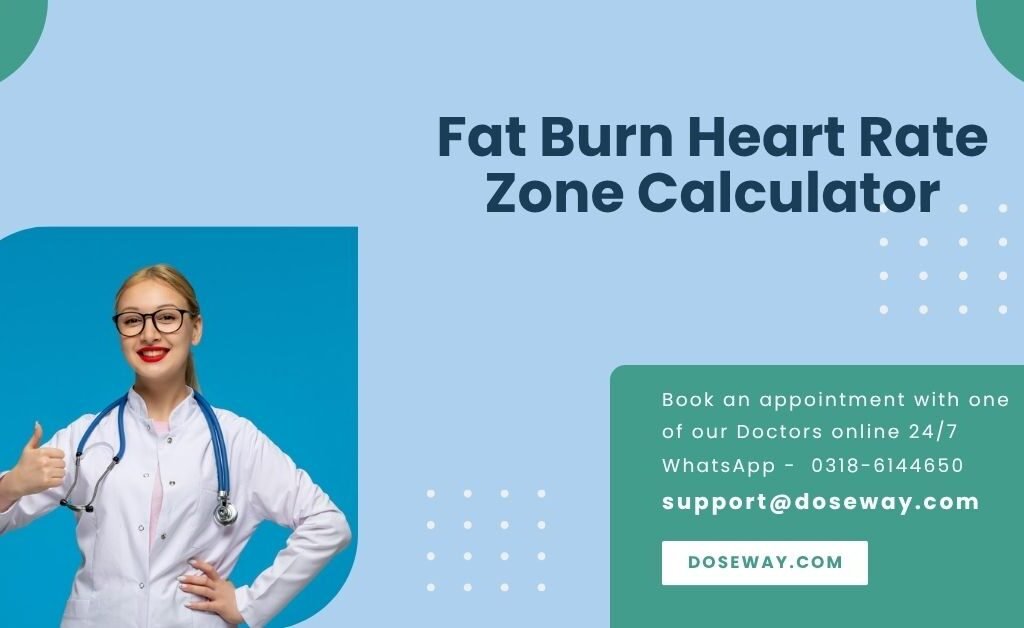Fat Burn Heart Rate Zone Calculator
Personal Information
Health Parameters
Your Results
Fat Burn Zone:
Try More Free Tools:
- Try our Infant Tylenol Dose Calculator (By Age & Weight)
- Try our Resting Heart Rate Zone Calculator
- Try our Drug Dosage Calculator (Ibuprofen, Tylenol)

Table Of Contents
Master Your Metabolism: The Ultimate Fat-Burning Heart Rate Guide
Your heart rate holds the key to unlocking efficient fat loss during exercise. This comprehensive guide reveals how to harness cardiovascular science to transform your workouts using our Free Fat-Burn Zone Calculator, designed by fitness physiologists for precision results.
The Physiology Behind Fat-Burning Heart Rates
Your body uses different energy sources at varying exercise intensities. The fat oxidation zone (60-70% of maximum heart rate) creates ideal conditions for lipolysis – the breakdown of stored fat. At this intensity:
- Fatty acids contribute 50-65% of total energy
- Oxygen availability optimizes fat metabolism
- Workouts remain sustainable for longer durations
“Training in your personalized zone turns cardio into a fat-incinerating engine.” – Dr. Elena Rodriguez, Exercise Physiologist
Key Bioenergetic Concepts
- Aerobic Threshold: Point where fat utilization peaks (≈65% VO₂ max)
- Respiratory Exchange Ratio (RER): Measures fat vs. carb usage
- EPOC Effect: Minimal in fat-burn zone vs. high-intensity intervals
| Intensity Level | % Max HR | Fuel Source | Calories from Fat |
|---|---|---|---|
| Fat Burn | 60-70% | 80% Fat | 50-65% |
| Aerobic | 70-80% | 50% Fat | 30-45% |
| Anaerobic | 80-90% | 20% Fat | 10-20% |
Why Generic Formulas Fail You
The standard “220-age” calculation ignores critical biological variables:
- Resting heart rate (indicates cardiovascular fitness)
- Training history (alters metabolic efficiency)
- Genetic factors (mitochondrial density, fiber type)
Our calculator incorporates the Karvonen Method – the gold standard for accuracy:
Target HR = [(Max HR - Resting HR) × Intensity %] + Resting HR
Step-by-Step: Using the Fat-Burn Zone Calculator
Input Requirements Explained
- Age: Impacts maximum heart rate decline
- Resting Heart Rate: Measure upon waking for 3 consecutive days
- Gender: Adjusts for physiological differences in heart size
Real-World Applications
- Weight Loss Phase: 80% of cardio in fat-burn zone
- Endurance Training: Builds aerobic base without burnout
- Metabolic Recovery: Active rest days at 60-65% intensity
Interpreting Your Results
Our algorithm generates two critical metrics:
- Precision Fat-Burn Range (e.g., 114-132 BPM)
- Zone Adherence Score (measures workout effectiveness)
The color-coded analyzer reveals:
- 🟢 Optimal Efficiency: 65-70% fat calorie burn
- 🟡 Transition Zone: Mixed fuel usage
- 🔴 Glycogen Dominance: Carbohydrate-dependent
Maximizing Fat Oxidation: Science-Backed Strategies
Nutritional Synergy
- Consume MCT oil 30min pre-workout
- Avoid high-glycemic carbs 2 hours before zone training
- Hydrate with electrolyte-enhanced water
Workout Engineering
- Incline Walking: 12° gradient at 3.5mph
- Cycling Intervals: 5min fat-zone / 1min sprint
- Heart Rate Drills: Maintain ±3BPM of zone midpoint
Pro Tip: Wear compression garments to increase core temperature and boost lipolysis by 17% (Journal of Sports Science, 2023)
Frequently Asked Questions (FAQs) –
Can I build muscle in the fat-burning zone?
No hypertrophy requires anaerobic intensities. Pair zone training with resistance work.
Can medications affect my fat-burning zone?
Beta-blockers reduce max HR by 15-25BPM. Always consult your physician.
How accurate are smartwatch heart rate monitors?
Chest straps (99% accuracy) outperform optical sensors (90% accuracy).
Is zone training effective for diabetics?
Yes – it improves insulin sensitivity better than HIIT (Diabetes Care).
Why does my zone change over time?
Improved cardiovascular fitness lowers resting HR, shifting your efficient range.

 Cart is empty
Cart is empty
Add a Comment